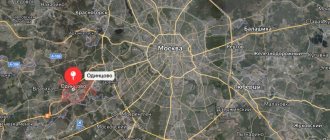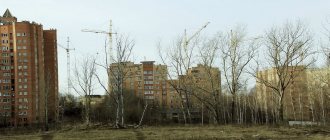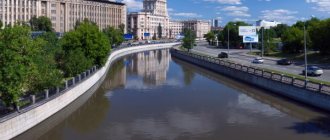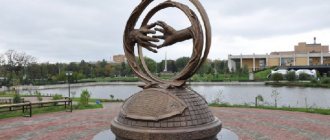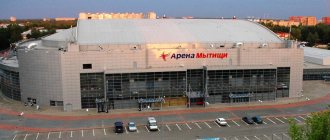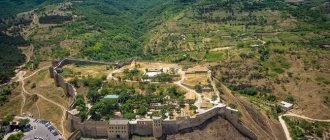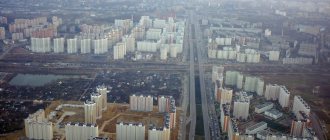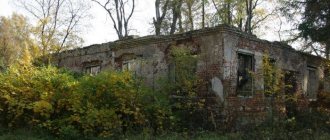Mytishchi
, a city of regional subordination in Russia, the administrative center of the Mytishchi urban district of the Moscow region, the center of the Mytishchi deanery of the Sergiev Posad diocese. Located on the western outskirts of the Meshchera Lowland, on the Yauza River and its tributaries - the Rabotnya and Sukromka rivers, 19 km northeast of Moscow. Railway station on the Moscow-Arkhangelsk line. The Moscow Ring Road adjoins the city borders. Sheremetyevo Airport is located in close proximity. Population 201 thousand (2016)
- On the map: Yandex.Map, Google map
At the end of the 16th century, the village of Loshakovo was located on this site. When the settlements that suffered during the Time of Troubles gradually began to revive, the peasants who lived near Loshakovo, behind the Yauzsky swamp, in the village of Zabolotye, decided to move to a drier and more convenient place. They moved their huts to the place where in ancient times they collected toll - the duty for transporting goods. Thus, on the Yauzsky “Mytishche” (from the word “myt”), a new village arose near the Pereyaslavskaya road, which was named Mytishchi. The wooden church of St. Nicholas the Wonderworker was also moved here from Zabolotye.
Since the peasant settlers previously lived on Losiny Island and were among the servants of the Trapper Path, which provided the royal hunt and monitored the protected forest, the part of the village of Mytishchi where they settled began to be called the Trapper Path and belonged to the royal court. The second half of the village belonged to the Trinity-Sergius Monastery. The church stood on the Trinity half of the village. By decree of the patriarch, it was ordered “the two villages of Ruposova and Sharapova, which were in the parish of the Church of the Epiphany, in the village of Nikolaevsky, ... to be in the parish, close to the Church of St. Nicholas the Wonderworker, in the village of Mytishchi.”
.
In the middle of the 17th century, the population of Mytishchi increased to 392 people due to the resettlement of peasants from other palace villages and hamlets here on the instructions of the Tsar. On the opposite bank of the Yauza, Zarechnaya Sloboda arose, and in 1683, a new settlement appeared near the Trinity Road - Novoselki, which later received the name Malye Mytishchi. From that time on, the village on the Yauza began to be called Bolshie Mytishchi.
By the end of the 17th century, the village of Mytishchi completely became a palace property. Its population grew steadily and by the end of the 18th century exceeded six hundred people. By the time serfdom was abolished, the village on the Yauza consisted of two parts - the village of Bolshie Mytishchi and Zarechnaya Sloboda with a total population of over nine hundred people. Its socio-economic situation also changed, which was significantly influenced by the opening of the Moscow - Sergiev Posad railway in 1862.
Personally, free peasants began to work in factories and factories, engage in trade, and carry out carriages. Inns, taverns, drinking houses, and shops began to open in the village. Several brick factories operated near Mytishchi, and in 1896 the Carriage Building Plant was founded, which later became a city-forming enterprise. In 1908, the Viscose artificial silk factory opened next to the plant. A workers' settlement grew up around the plant and factory. Thanks to the establishment of zemstvos in Mytishchi in 1872, the first zemstvo school in the Moscow district was opened.
From the 1913 census it is clear that at that time Mytishchi was a factory village with a population of seven thousand people.
Mytishchi workers took an active part in the revolutionary events of 1917. After the revolution and civil war, during the period of restoration of the national economy, the influx of workers began again in Mytishchi. This affected the quantitative and social composition of the village of Bolshie Mytishchi.
In 1919, Mytishchenskaya volost was renamed Proletarskaya.
On August 17, 1925, the city of Mytishchi was formed; at that time, over ten thousand people lived in it.
In 1932, the surrounding villages of Bolshie Mytishchi, Zarechnaya Sloboda, the villages of Perlovka, Taininka, Druzhba, the villages of Rupasovo, Sharapovo, Leonidovka, and Taininsky settlements were included in the city boundaries.
On November 25, 2015, Mytishchi received the status of a city of regional subordination, and the urban-type settlement of Pirogovsky was included within its boundaries.
General information and history of Mytishchi
The Moscow region is replete with a huge number of different cities, villages and towns, but some of them rightfully deserve special attention.
One of these settlements is the city of Mytishchi, located on the Yauza River, 19 kilometers from the heart of the capital. Despite its rather small area, the city is secretly considered one of the largest cultural and industrial centers in the Moscow region. Which is not surprising! After all, it arose back in 1460 (at that time Mytishchi had the status of a village). This was a point for collecting customs duties from merchant ships sailing along the Yauza.
A little later, when this improvised customs house was moved to Moscow, Mytishchi acquired the status of a completely independent settlement, where people were mainly engaged in fishing and farming.
Already in our time, when this settlement acquired the status of a city, people were attracted to it by a certain tranquility and the opportunity to simply relax, and the main place of recreation was Chelnkovsky Park. Unfortunately, it quickly fell into disrepair and was built up. But now the city has a huge central recreation park, which restores the very atmosphere that characterized the city throughout the history of its existence.
History of the city of Mytishchi
Mytishchi is one of the largest cities in the Moscow region, an industrial and cultural center, a satellite city of Moscow 1-
th belt. The development of the city is inextricably linked with Moscow and at the same time original. Below is a brief history of the city of Mytishchi.
Until the 17th century.
The first mention of the settlement of Mytishchi dates back to the middle of the 15th century. Then in 1460
year, the monk of the Simonov Monastery Yarlyk wrote in a spiritual letter about the village of Yauzskoe Mytishche.
But archaeological excavations say that Slavic tribes lived in the territory of the future city from the end of the 1st century AD. With the development of crafts and trade, a land crossing arose here for merchant boats that went from the Moscow River to Klyazma - Volok. This was an important part of the trade route and a tax was levied for passage along the portage - myt. By the 14th
century, the direct route down the Moskva Veka to the Oka became safe; the portage was abandoned, but a village remained in its place.
The toponym “Mytishche” stands for the place where it was washed. As the territory of the village grew, the word “Mytishche” became plural, and the village began to be called Mytishchi, and subsequently Bolshie Mytishchi. During the time of troubles (the beginning of the 17th
century), the population left the village and surrounding villages due to the Polish intervention, but after the end of the troubles, when Tsar Mikhail Romanov ascended the Russian throne, life returned to Mytishchi.
From the 17th to the 20th century
Its geographical location has always played an important role in the history of the village. It was adjacent to the road to the Trinity-Sergius Lavra, now the Yaroslavl Highway, and since ancient times pilgrims, including those of noble origin, walked along it and went to pray. In the neighboring village of Taininsky there was a travel palace of Tsar Alexei Mikhailovich, and in the next century Empress Elizaveta Petrovna fell in love with staying in Mytishchi. By the middle of the XVIII
century, the village became a favorite place for pilgrims to relax, as well as just for walks for Muscovites who wanted to taste the village flavor.
Mytishchi and the surrounding area were famous for their springs and wells, the water was clean and tasty, so tea drinking became one of the main leisure activities of the village. The artist Perov even immortalized the tea party in Mytishchi in a painting of the same name. Due to the shortage of drinking water in Moscow, Catherine the Great, appreciating the taste of water from Mytishchi springs, ordered the construction of a water supply system from Mytishchi. Construction was completed in 1804
.
The industrial revolution of the 19th
century also affected Mytishchi, and textile manufactories began to appear in the vicinity of the village.
The population increased after the abolition of serfdom. In 1862
, merchant Ivan Mamontov built a railway from Moscow to Sergiev Posad.
Mytishchi became the first station on the line. The development of the railway had a beneficial effect on the development of industry; brick factories appeared in Mytishchi. By the end the 19th
century, the railway had already reached Arkhangelsk and had several branches in the immediate vicinity of the village.
So Mytishchi station becomes a hub. At the station, the son of the railway founder, Savva Mamontov, built a carriage factory in 1897
, which became one of the main enterprises of the now workers' village.
Thanks to the railway and the ability to get outside the city in a couple of hours,
a fashion for dachas emerged the 19th In addition to dacha plots in Mytishchi itself, new dacha settlements Losinoostrovsky and Dzhamgarovsky are growing in the neighborhood.
XX century – and our time.
In XX
Century, the growth and development of the village continues.
In 1909
, next to the carriage building plant, the Viscose artificial silk factory was established.
After the revolution, important changes took place: in 1925
, Mytishchi received city status.
The development of industry continues, the Instrument-Making Plant, a number of light and chemical industry enterprises and research institutes on their basis are opened. To the northwest of the station there is a Red Army Communications Institute and a military camp. In 1929
, the section of the railway from Moscow to Mytishchi was electrified, Mytishchi became one of the first cities in the USSR where electric trains began running.
In 1939
, the city expanded to include neighboring villages, which gave their names to the city’s districts - Rupasovo, Leonidovka, Perlovka, Taininsky, Yadreevo and others.
After the war, several more scientific institutions appeared - the Institute of Vegetable Farming, the Cable Industry Design Bureau, and the Hygiene Research Center moved from Moscow. The development of its large neighbor, Moscow, and transport at the end the 20th
century entailed the actual integration of Mytishchi into the structure of Moscow, although nominally it is still an independent city.
Since the late 80s
, there has been a project to extend one of the metro lines in Mytishchi, with at least one station in the city.
In recent decades, active construction of residential areas, sports, cultural and leisure facilities has been underway. Nowadays, Mytishchi is a city of regional subordination, 5th
most populous city in the Moscow region (211,606 people), and is among the top hundred cities in Russia in terms of population.
Mytishchi is the center of the Mytishchi urban district, which extends far beyond the city itself, includes a number of villages and towns and covers an area of more than 430
square kilometers.
Climate and ecology of Mytishchi
For those who live in Moscow, it is probably already difficult to imagine what real winter or comfortable summer is like. But you don’t have to travel 100 kilometers to feel comfortable in both winter and summer. Mytishchi is a completely unique place in this regard! It can be said without exaggeration that the ecology of this city is one of the healthiest in the Moscow region, despite the presence of factories. For the most part, this is due to the fact that the transport system in Mytishchi almost does not allow vehicles to enter the center, thus maintaining a favorable microclimate.
Of course, this causes a number of difficulties with movement, but this is a small price to pay for people to feel comfortable and not suffer from poor ecology. Moreover, due to its favorable geographical location (as mentioned earlier, Mytishchi is located on the banks of a fairly large river), this place is very popular among those who want to get out of the big city or simply buy themselves a country house in one of the small settlements on outskirts.
One of the "green" areas of the city
Option No. 2
A city in the North-Eastern Moscow region, located 20 kilometers from the center of the capital, on the banks of the Yauza, which is attractive for potential residents when choosing apartments. The area of the city is 40 square kilometers. In terms of population, it ranks 94th out of 1,115 cities in Russia.
The history of the city's name goes deep into antiquity. In the 17th century, on the territory of present-day Mytishchi there was a port of the then navigable Yauza, where merchants paid the “myt” tax for their goods. Subsequently, the word “myt” was transformed into the name of the city of Mytishchi. The city itself dates back to the first century AD, as evidenced by archaeological finds. Since 1925, Mytishchi ceased to be a working village and received the status of a city.
The city is green, with many parks, a landscaped embankment, and a population of 222 thousand. Residents and guests of the city have a unique opportunity to watch moose calves and feed them. You can do this in the huge Losiny Ostrov national park, which is located within the city.
The city has military-themed monuments, as well as a modern monument to Samovar. Fans of cultural recreation in Mytishchi should visit the Mytishchi Drama and Comedy Theater “Fest”. The Mytishchi Historical and Art Museum preserves the history and traditions of the region. Be sure to check out the Mytishchi art gallery, which has a large collection of paintings. For active recreation, you should choose the Mytishchi Arena Ice Palace for a visit.
Cultural monuments have been preserved in Mytishchi. The station building, built in 1911, is an architectural monument, two wooden dachas of merchants Ageev and Buyanov have the status of an architectural monument, as well as the Church of the Vladimir Icon of the Mother of God built in 1713 and the Church of the Annunciation in Taininsky, built in 1675.
Most of the population works in the industrial area of the city. Brand new subway cars are being produced from the assembly lines of local factories. The electronics and chemical industries are developed. Cables, synthetic resins, plastic products, sidewalks, and curbs are produced here. There is a wood processing plant. The Titan jewelry factory produces products from precious metals. The Znamya Truda knitting factory produces a wide selection of knitted products.
The city has several universities, a mechanical engineering college and a medical school.
Population of Mytishchi
Although the population in Mytishchi is only about 183 thousand people, all of them, influenced by the atmosphere of the city, are somewhat different from the residents of Moscow and other settlements.
Of course, it is worth taking into account the fact that in recent years more and more people have been trying to move to the Moscow region (and this is quite natural). And thus the urban population somewhat dilutes the conglomerate that has already formed inside Mytishchi. But an amazing fact is that after living for some time in the city or on its outskirts, even native Muscovites begin to change, adapting to the measured flow of life in this extraordinary place!
Mytishchi station
When you go outside, especially in the summer, you can see children frolicking on playgrounds, teenagers playing football or volleyball, and calm adults calmly walking along the streets as if nothing bothers them. Isn’t it a strange picture for a city that is only half an hour’s drive from the bustling capital? And what’s most remarkable is that you get the impression that all the people around you understand: passers-by will politely explain how to get to the right place, sellers, most often, are very courteous. Of course, this does not always happen, but the overall picture is very pleasant: the city is full of cultured, educated people and well-mannered young people.
Unfortunately, this does not change the fact that in the evenings in some areas there is a high probability of encountering hooligans or drunkards. No matter how sad it is to talk about it, alcoholism is the scourge of our nation, and many people are not spared. We have to reckon with the fact.
However, looking at all this from the outside, you understand that minor troubles pale in comparison to the general positive traits of the residents of Mytishchi. After all, everything can't be all good or all bad.
Districts and real estate of Mytishchi
Mytishchi Map
Since the city is quite small, there is no clear zoning in it, however, as in other cities of this type, the city can be roughly divided into districts according to the names of major streets. For example, the area of Krasnaya Street (one of the largest residential areas, which smoothly leads to the Yaroslavl highway), the area of the Stroitel platform (the second largest residential area in terms of area, and also the working center of the city), the Dynamo area and, in fact, the center itself, located on Olympic Avenue.
By the way, this very avenue is secretly the main recreation area for the local population, since quite large bodies of water are concentrated along it and in general the atmosphere there predisposes to this.
Olympic Avenue
Not only the famous central park serves as a place of pilgrimage for the local population, who spend every weekend by the water, somewhere on the banks of the Yauza, central reservoirs, or travel outside the city.
Yauza embankment
For example, Kolontsova Street, the main street leading from the Mytishchi railway station, is an unofficial walking boulevard. And not only because people constantly travel there, in the work flow. In the evenings, local youth gather there; during the day, everyone fusses, diving into one store, then into another. In addition, the business center located on this street provides a large number of people with work. So, life in this part of the city is in full swing sometimes even more than in its center.
Another notable place is the Solnechnaya Street area. One of those rare cases when the title matches the content, but not in the literal sense. This microdistrict can be considered one of the most comfortable in the entire city, since it looks more like a village that suddenly appeared among high-rise buildings. It turns out to be a rather interesting picture: it seems like a city, a lot of houses, cars and shops, trees all around, but when you drive a few hundred meters, you see wooden houses, as if you were outside the city!
Old against the background of new
In general, the northeastern region of the city is distinguished not only by the huge amount of greenery and the small number of people living in it, but also by the number of new buildings. There really are a lot of them there. And the prices for apartments, in contrast to Moscow, are simply ridiculous - about 7 million rubles for a new two-room apartment. Perhaps such housing prices and the favorable location between Moscow and Korolev caused a sharp influx of new residents to Mytishchi.
It’s hard not to mention Letnaya Street. As you can see, the street names in Mytishchi are very positive and this is no coincidence. After all, Summer most often becomes a place for holding all kinds of folk festivals, as well as just a walking area for local residents. And what a delight the local ponds are for young children!
Square with fountains in Mytishchi
This is a must see. On the one hand, there is nothing remarkable in this territory, but on the other hand, as in the famous saying, there is an atmosphere here that is difficult to convey in words. It’s easier to find yourself there once, on the eve of some holiday, and feel the power of that extraordinary atmosphere that is created both by the people and the place itself.
Historical reference
The history of the region goes back centuries. The first inhabitants - tribes of Neolithic hunters and fishermen of the Lyalovo culture - appeared here back in the 4th millennium BC. e. In the Bronze Age (2nd millennium BC), cattle breeders and metallurgists of the Fatyanovo culture lived on the Mytishchi land, and in the Iron Age (1st millennium BC) they were replaced by tribes of the Dyakovo culture, who built fortified villages on river capes , were engaged in cattle breeding and agriculture, and mastered iron production.
The Slavs - Vyatichi and Krivichi - came here at the end of the 1st millennium AD. e. In the area between the Ucha and Klyazma rivers there was a conventional border between these tribes; here was the zone of their mutual penetration. Mixed burial mounds with Vyatic and Krivik burials are known. In the ancient Russian era, the Mytishchi region was quite densely populated. Now there are 12 settlements and settlements known here from the 9th to the 13th centuries, one of which is located on the banks of the Yauza within the boundaries of the modern city of Mytishchi. The Slavs brought with them a developed culture of arable farming, raised livestock, and were well acquainted with various crafts - metallurgy, blacksmithing, pottery, carpentry, and jewelry.
In the 11th - 14th centuries, an important trade waterway passed through the Mytishchi land along the Yauza and Klyazma rivers. This path has existed since time immemorial, long before the founding of Moscow. At the place where Mytishchi is located, there was a collection point for passing duties from people and ships, which bore the general name - myt. “Yauza Mytishche” was first mentioned in the spiritual letter of the monk of the Simonovsky Monastery Adrian Yarlyk, dated July 1460. From Yauza to Klyazma, merchant ships were dragged overland over a distance of about 7-8 kilometers. The name of the city is associated with this trade route. The diagram of the ancient portage is shown on one of the stands of the local history museum.
In 1623-1624, in the scribe book of the estates of the Trinity-Sergius Monastery of the Moscow district, Mytishchi is mentioned: “The village of Mytishchi was half the village of Loshakova on the river in Mytishche, and in it there was a church on the Trinity half in the name of St. Nicholas the Wonderworker.” In 2003, Mytishchi celebrated 380 years since its first mention as a village.
Within the city of Mytishchi there is the ancient village of Taininskoye (formerly Toninskoye), known since the beginning of the 15th century, - the hereditary patrimony of the great Moscow princes and Russian sovereigns, which served as their country residence. Rich palace chambers and outbuildings were erected here. This village near Moscow was the favorite estate of Ivan the Terrible, one of the centers of the oprichnina. Tsar Alexei Mikhailovich often visited here on his way to a pilgrimage to the Trinity-Sergius Lavra and rested in a specially built “travel palace.” By his decree, in 1675-1677, a stone manor church of the Annunciation, unique for Russian architecture, was erected next to the palace. Empresses Elizaveta Petrovna and Catherine II visited Taininsky.
In 1749, on the site of more ancient buildings, a new wooden palace was built in the then fashionable “Chinese style”, new residential and utility buildings appeared, and the palace garden was re-laid. At the end of the 18th century, the estate was abandoned and gradually fell into disrepair. Its destruction was completed by the great fire of 1824.
The upper reaches of the Yauza River have long been famous for its spring water. It was from here that the construction of the first Moscow gravity water pipeline began in 1779. Construction lasted 25 years and was completed in 1804. The water pipeline was quite a complex engineering structure for that time. Water from 28 key wells flowed into a brick-lined gallery that stretched 19 miles to Moscow. The Rostokinsky aqueduct has survived to this day - in the place where the water pipeline gallery crossed the Yauza riverbed.
In the second half of the 19th century, industry began to develop rapidly in the urban district of Mytishchi. Plants and factories were built mainly near the Northern Railway line, built in 1862. In 1897, the carriage building plant produced its first products, and in 1909, the first artificial silk factory in Russia, Viscose. Gradually, a large industrial center emerged in the village of Bolshie Mytishchi. There was also a railway junction here.
In 1922, a “working garden city” was founded - the village of Druzhba and the village of Tabachnik (Leonidovka microdistrict), etc. By 1926, the population exceeded 10 thousand people.
In 1925, Mytishchi received city status. During the pre-war five-year plans, the appearance of the city changed greatly due to the commissioning of a new hospital building, a car factory club, and a sculpture factory (art casting plant). The chemical industry began to develop on the basis of the Viscose factory.
From 1932 to 1937, the route of the Moscow Canal, the world’s first energy canal, passed through the territory of the region. In 1932, the villages of Rupasovo, Sharapovo, the villages of Bolshiye Mytishchi, Taininskoye, Zarechnaya Sloboda, the villages of Perlovsky, Taininsky, Leonidovka and Druzhba were included within the city limits. There was a need to build new microdistricts, but the war prevented the implementation of these plans.
During the Great Patriotic War, residents of the city and region contributed to the overall victory over the enemy. Over 45 thousand Mytishchi residents went to the front. More than 20 thousand of them did not return from the battlefields. All enterprises switched to the production of military products. 6 hospitals were deployed and a fighter battalion was formed. The “Mytishchi Collective Farmer” tank column and the “Moscow” air squadron were built at the expense of the region’s workers. Thousands of Mytishchi residents were awarded orders and medals, 22 were awarded the title of Hero of the Soviet Union, three became full holders of the Order of Glory. Among them A.I. Egorov, A.I. Kadomtsev, N.P. Seleznev, M.I. Tolmachev, N.M. Raspopova, V.I. Karpenko, I.A. Korablin and others.
City infrastructure
When you get to Mytishchi, you immediately notice the condition of the buildings and the city as a whole. Considering the fact that the city itself is quite young, the external and internal appearance of the buildings looks as if the houses were rebuilt quite recently. To some extent, this is true, since there are many more new buildings here than old houses, and renovations are carried out every two to three years. This has a positive effect on the general condition of the entire city infrastructure, so local residents rarely experience problems with heating or water supply.
New buildings
But power outages, for unknown reasons, are not such a rare phenomenon. This is especially true for the outskirts, which, at the behest of a holy occasion, are periodically left without light for several hours. But this, in fact, is not so critical, since local housing and communal services authorities correct such problems quite quickly.
Looking at the roads of the city, you might think that no one drives on them, because they look as if the asphalt was only recently laid. In fact, the statement that “no one drives” is not far from the truth.
The transport system of Mytishchi is such that, for the most part, practically no one travels around in the city center. But the famous traffic jam on the Yaroslavl highway every day causes a lot of problems for both local residents and visitors.
Traffic jam on Yaroslavsky
It is difficult to say how many motorists have already achieved driving zen, standing in an endless traffic jam that stretches in the direction Mytishchi - Moscow every day. The saddest thing is that this problem with entry and exit has not been solved for many years. However, in recent years, the authorities have decided to think about this problem and begin to actively build interchanges that will split the flow of drivers into several nearby ones. This promises to solve the transport problem, but the result is not entirely clear at the moment.
Those who cannot stand the atmosphere of endless waiting in cramped cars choose other ways to get to their desired destination. One of these ways is the railway. This part of the Mytishchi transport system works like a Swiss watch. Every day, thousands of people rush to the platform to get to work or school using commuter trains. They come here often and are almost never late. Despite the fact that sometimes such a journey turns out to be very tiring (since there are really a lot of people, in the morning, as a rule, all the trains are packed to capacity so that there are simply no empty seats left), such a solution is still better than the unknown in the form of waiting for a miracle in traffic jam on Yaroslavskoe highway.
Those who do not have their own vehicle, and do not consider electric trains as transport at all, have mastered the method of traveling from Mytishchi to nearby areas using buses. Some drivers have designed their passenger transportation system to bypass traffic jams in a roundabout way. This, of course, also takes time, but it saves the patience of passengers and the nerves of the driver himself. Be that as it may, there are no special problems with transport in Mytishchi, which cannot but please the local population.
Enterprises and work in Mytishchi
One only has to remember how many people live in the city to understand that it is impossible to provide work for everyone. This is understandable - after all, Mytishchi is not exactly an industrial city, although several large industries are located on its territory.
One of these is a machine-building plant, which, in fact, provides jobs for most of the population. Its main specialization is the production of subway cars. It can almost be considered the largest plant in this area. Since such a large enterprise is simply obliged to maintain its brand, working conditions in production attract more and more new workers.
At the entrance of the METROVAGONMASH plant
Another fairly well-known plant is the instrument-making plant. This place is special in its own way and is somewhat different from all other production facilities, not so much in the specifics of production, but in the people who work there. For the most part, these are graduates of technical universities, both in the city itself and in Moscow, who want to try themselves in action. Having been there once, it’s easy to draw an analogy with some film about secret developments. The workers are either calm and quiet, or scurrying along the corridors, as if one of them had invented something completely unusual, but you can’t talk about it. All that remains is to be surprised and double-check the data. But this is only an external impression; one can only guess what it looks like from the inside.
Of course, it would be foolish to assume that everyone works in factories. Despite the small area, Mytishchi has several large businesses and others. They are, as a rule, located in the central parts of the city, for greater convenience or in crowded places (Horizon, for example, is located right next to the Mytishchi railway station, which attracts not only local residents, but also people from the surrounding areas).
Sberbank building in Mytishchi
And now a lyrical digression about shopping centers. Shopping centers in Mytishchi are being built like mushrooms after rain. It’s simply impossible not to find a suitable place for entertainment or shopping! Just look at XL alone (although it is not located in the city itself, but a little further, in the region). But it can rightfully be considered the largest regional shopping center. It’s easier to say what can’t be found there, since the assortment is so large that one can only shrug at how this giant was built in the first place. Add to this the IMAX cinema located opposite the shopping center and the water park and you will get the most visited place not only for residents of Mytishchi, but also for Moscow and Korolev.
Shopping center XL on Yaroslavskoe highway
However, in the center of Mytishchi you can find smaller analogues, and even small fairs that retain the atmosphere of the Soviet era and are so popular among the older generation.
Used materials
- “City district today. General information", website of the Mytishchi Urban District:
- History of the Mytishchi Vladimir Church on the official parish website
- “Mytishchi”, website People's Encyclopedia of Cities and Regions of Russia “My City”
- “Mytishchi district”, page of the official website of the Moscow diocese:
- “Mytishchi, churches and monasteries”, website “People's catalog of Orthodox architecture”:
[1] Journal No. 4 of the meeting of the Holy Synod of the Russian Orthodox Church dated April 13, 2022,
Crime
It’s sad to admit, but Mytishchi, despite its peaceful atmosphere, is considered a city with a very high crime rate. Blatant statistics show that in 2010 Mytishchi was among the top three in terms of crime rates for the year.
It is difficult to say what the basis for such data is. After all, if you look at the city from the outside, it seems that everything is in order and you cannot find a calmer place. But as soon as night falls on the ground, people seem to go wild and it’s better not to go out again. Of course, one cannot take this to the point of absurdity and assume that since this happens, then every third resident of Mytishchi is a maniac killer, but it is better to observe safety measures. This also does not mean that when you go out into the street, you are 100% likely to fall into the hands of a robber or murderer. Perhaps the latest such high-profile news was the murder of a child. Now there is an active investigation into it and a search for those responsible. However, there is no evidence or direct evidence.
Perhaps the most common crime in this city is domestic murder (it’s not hard to guess for what reason). According to the local police department, such murders occur from 17 to 25 per year. Which, you must agree, is quite a large number. However, about 50 percent of such murders are committed by visitors, which slightly changes the view of the city itself. Another type of “crime,” although it is more of a crime, is all kinds of thefts and scams, which, as a rule, are committed on the basis of the sale or purchase of expensive property. For example, just recently the owner of a multi-storey building, which was built completely illegally, was arrested. Moreover, apartments in the still unfinished building are already on active sale.
